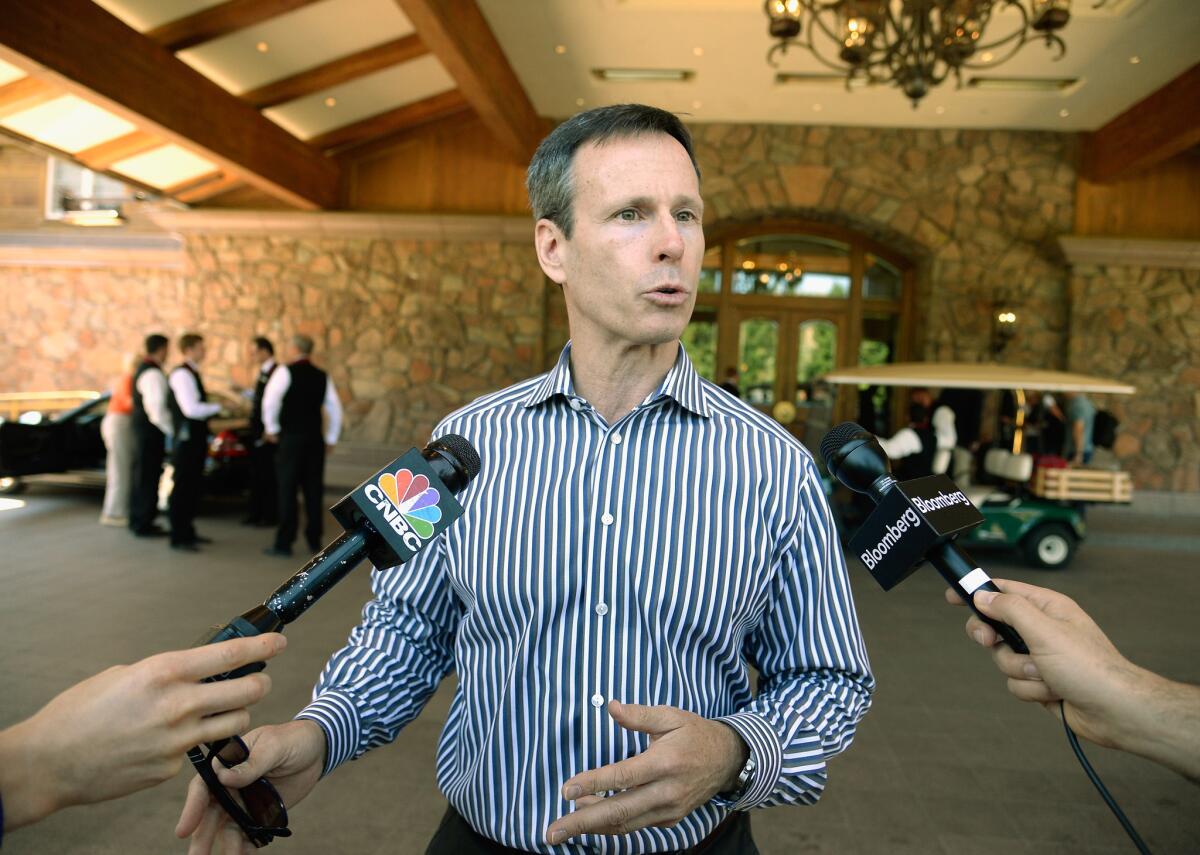Disney’s not alone in succession woes

Thomas Staggs, chairman of Walt Disney Parks and Resorts, will be stepping down from the company.
- Share via
The resignation of Thomas Staggs, heir apparent to the top job at Walt Disney Co., shows once again that even the best-laid plans for CEO succession can go awry.
Over the last decade, such corporate stalwarts as Hewlett-Packard, Cisco Systems and Lockheed Martin have seen designated heirs to the top executive seat abruptly depart.
“Any time a natural successor is no longer in the running, it creates questions,” said Charles Elson, director of the John L. Weinberg Center for Corporate Governance at the University of Delaware. “For the company, it throws some uncertainty into the mix.”
Botching a succession at the top can be costly. Disney shares fell nearly 2% in after-hours trading on news of Staggs’ planned departure.
Strategy&, formerly Booz & Co., analyzed 4,498 CEO successions from 2000 to 2014 and found that companies forced to fire their leader lost $1.8 billion in shareholder value compared with companies that orchestrate a replacement.
It was unclear what led Staggs to step down. But Disney brings its own rich history of turmoil in the executive suite.
Two decades ago, the company was embroiled in a battle between Michael Eisner, the chief executive at the time, and his second-in-command Jeffrey Katzenberg.
Katzenberg, spurned for the No. 2 job after the death of Frank G. Wells in a helicopter crash, claimed that Disney reneged on a pledge to give him 2% of profits of films and TV shows put into production or acquired during his 10-year tenure as the company’s top movie executive.
The fight nearly turned into a public courtroom drama. It was settled in 1997, but cost Disney about $270 million and sealed Eisner’s demise.
To no one’s astonishment, show business is littered with examples of C-suite skirmishes that would make the characters from “Game of Thrones” blush.
Warner Bros. famously pulled the plug on its president and CEO Alan Horn in 2011, even after he presided over a string of mega-hits such as “Harry Potter” and “The Dark Knight.” Horn, who is now chairman of Walt Disney Studios, was pushed out for Warner Bros.’ chairman, Barry Meyer.
The move was aimed at building stability and appeasing Wall Street. The result was anything but. Over the coming years, other executives would leave Warner Bros. after learning that they wouldn’t be tapped to replace Meyer.
More recently, there’s the intrigue-filled succession at CBS and Viacom, which had been headed by aging media mogul Sumner Redstone, 92.
Redstone’s declining health has complicated the naming of an heir. Shari Redstone — his daughter and a company executive — is battling Viacom chief Philippe Dauman for control.
SIGN UP for the free California Inc. business newsletter >>
Part of the reason that a board’s vision may not pan out is that human resources often don’t top its priority list, said Scott Saslow, CEO of the Institute of Executive Development.
“This is not seen as exciting or sexy,” he said.
Saslow added that at large companies, human resources departments may get two meetings with board members per year, and “are rarely treated as a real peer or equal to the board in the succession process.”
Another factor: Incumbents often are not itching to give up power.
Iger’s retirement was first set for 2015, and it has been extended twice, most recently through 2018.
Personal drama can also intervene. In 2014, before Mohamed El-Erian abruptly resigned as CEO of Pacific Management Investment Co., the Newport Beach firm where he was expected to take over for Bill Gross, Pimco’s co-founder and former chief investment officer, the two clashed over tactics and Gross’ management style.
In a lawsuit filed against Pimco in Orange County Superior Court last year, Gross blamed El-Erian for a risky investment strategy and said that a “cabal” of managing directors had been plotting to oust him as a result of their “lust for power, greed and a desire to improve their own financial position.”
“There is some perverse incentive to have a CEO who drives and owns the process and for them it’s not in their best interest to make sure there’s a bunch of people who can replace them,” Saslow said.
Times staff writer Ryan Faughnder contributed to this report.
ALSO
Tesla misses delivery target, citing company ‘hubris’
Alaska Air to buy Virgin America, stripping California of its only major airline
Amazon takes on PayPal with expanded payments-processing service
More to Read
Inside the business of entertainment
The Wide Shot brings you news, analysis and insights on everything from streaming wars to production — and what it all means for the future.
You may occasionally receive promotional content from the Los Angeles Times.











